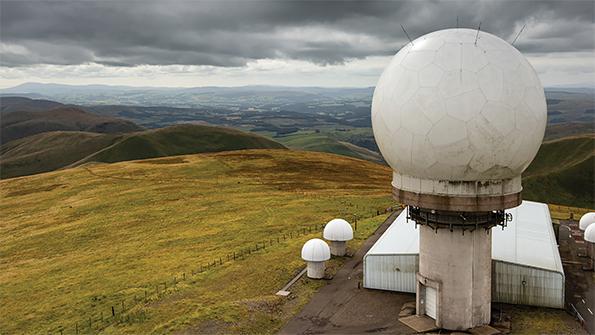
UK NATS is selling a number of dormant radar sites as well as leasing space at other locations to reduce its costs and raise revenue during the COVID-19 pandemic—moves made possible, it says, by advances in technology.
“This is absolutely not about selling off the family silver,” Paul Hughes, NATS head of assets and development, said in an Oct. 1 announcement of the land sales.
- Air traffic volume over the UK remains down
- NATS stops educating new controller trainees
- New-technology radar planned at Scotland site
“We are maintaining full ownership and access to all our critical infrastructure,” Hughes adds. “But where we have land and accommodation we no longer need, it makes sense to find a better use for it while also helping us reduce our maintenance and running costs at what remains a very difficult time for the aviation industry.”
The UK air navigation service provider (ANSP) is divesting unused radar sites at a time when the air traffic activity it manages stands at 40% of the level it handled a year ago. As with other ANSPs in Europe, the public-private partnership, which is 49% owned by the UK government, has been hit hard by the pandemic-related lapse in air travel and the resulting loss of revenues it generates through its air traffic services.
At the front end of the pandemic, in March and April, NATS controllers managed only about 10% of normal traffic levels. In mid-April, the ANSP received a £92 million ($119 million) loan from Eurocontrol to help cover its operating expenses. NATS En Route plc, its operating subsidiary, furloughed more than half of its staff.
But air traffic in Europe has not rebounded as ANSPs had hoped.
“In our response to the impact the pandemic is having on the aviation industry, we have prioritized protecting operational jobs to ensure we have the capacity to manage traffic when it returns to 2019 levels,” NATS CEO Martin Rolfe wrote in a Sept. 16 blog post. “That’s why we did not include our controllers in the voluntary redundancy program we launched in August, under which we will sadly say goodbye to several hundred of our nonoperational colleagues by November.”
In September, NATS notified 122 controller trainees at its college in Whiteley, England, that it was ending their instruction. A review of training needs with the Prospect trade union had concluded that “there is no realistic scenario in which [NATS] will need further trainees from the college until 2022 at the earliest,” Rolfe wrote. “In fact, we will not have any capacity to support further new trainees at Swanwick, our biggest operational center, for the next two years.”
NATS is divesting unused radar sites and leasing other space while simultaneously modernizing its infrastructure.
On Sept. 28, the ANSP said it is investing in a new radar capable of filtering out false returns from wind turbines at its Lowther Hill, Scotland, site. Long-range surveillance radar at that location provides coverage of the central belt of Scotland, including the cities of Glasgow and Edinburgh, the southern part of the country, northern England and parts of the Irish Sea and Northern Ireland.
Expected to enter service in late 2021, the new radar will replace the Raytheon ASR-23 L-band primary surveillance radar now at Lowther Hill. NATS declined to identify the supplier or the cost of its investment, saying it plans to release a tender for its next radar replacement program soon and does not want to prejudice that process.
The NATS press release announcing the new wind turbine mitigation radar describes it as a shared investment “with developers that benefit from it, then [contribute] to its ongoing operation.”
Separately, Raytheon’s UK subsidiary on Sept. 29 announced that it has completed the construction of a new radar testing and training facility at Solent Airport in Hampshire, England, on behalf of NATS. The new Radar Reference Facility comes with a contract Raytheon UK won in June 2016 to supply primary surveillance and Mode S monopulse secondary surveillance radars at 23 sites across the UK.
NATS says it has 70 acres of land available for sale at six radar sites and has heard from potential buyers, including home builders and local entrepreneurs. As part of its broader strategy of responding to the coronavirus pandemic, it has partnered with Shared Access, an owner and operator of shared wireless communications towers, to lease space at some sites to mobile telecommunications companies.
“We have 124 sites all over the country that would be perfect locations for mobile phone networks to put their own masts and antennas, helping to improve coverage in harder-to-reach locations and giving us a new source of income,” Hughes says.


